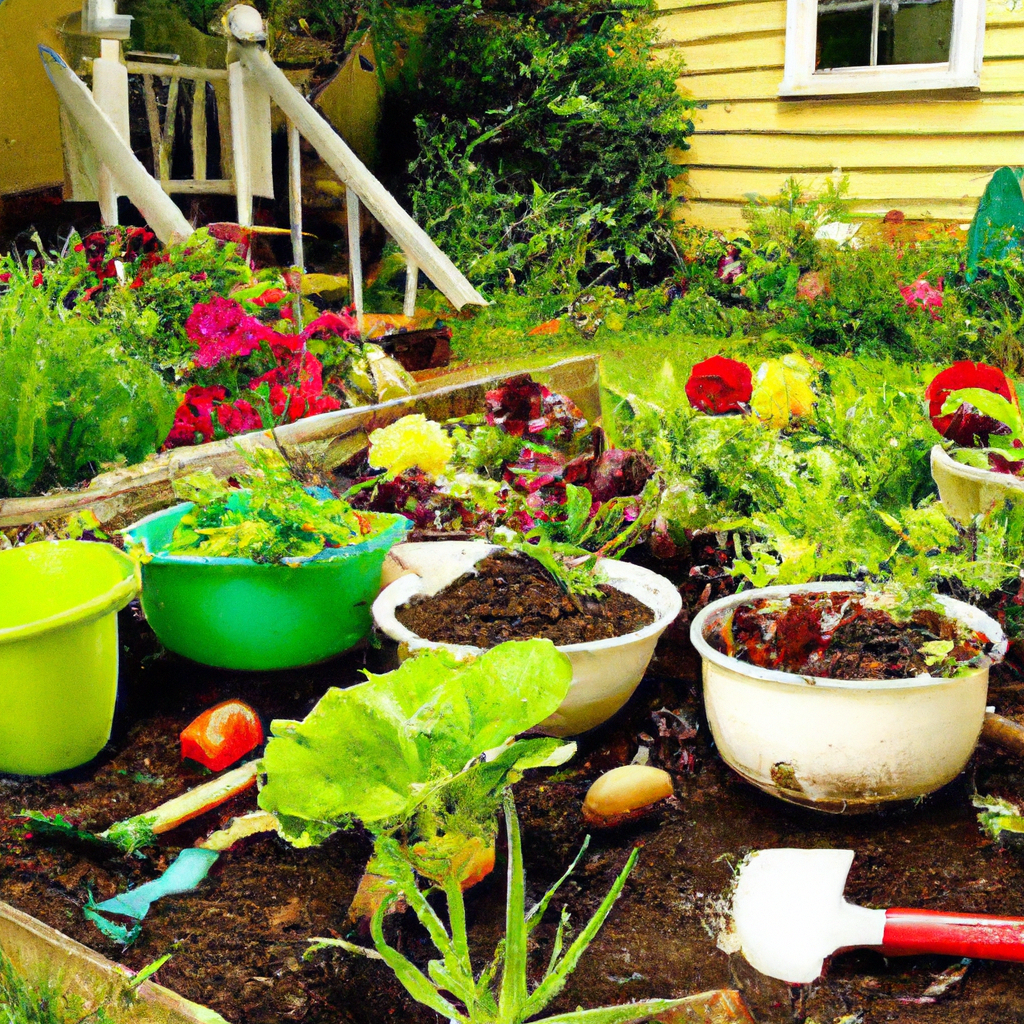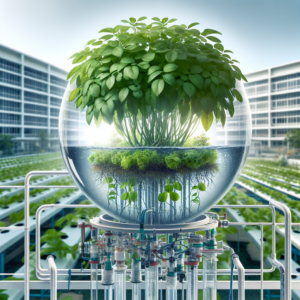
Are you looking to create an engaging and sustainable educational garden at your school? Look no further! This article will provide you with valuable insights and tips on how to turn an ordinary piece of land into a vibrant learning environment. From selecting the right plants to involving students in the project, get ready to embark on an exciting journey towards fostering environmental awareness and hands-on learning in your school community. Let’s explore the wonderful world of school and educational gardens together!

Choosing a Suitable Location
Consider the available space
When choosing a location for your school’s educational garden, it’s important to consider the available space. Look for an area that is large enough to accommodate your garden plans, whether it be a small plot or a larger area. Take into consideration any existing structures or trees that may restrict the amount of space you have available.
Evaluate the soil quality
The quality of the soil in your chosen location will play a large role in the success of your garden. Test the soil for pH levels, nutrient content, and contaminants. If the soil is lacking in nutrients or is contaminated, you may need to amend it with organic matter or consider using raised beds or containers.
Assess sun exposure and shade
Plants require varying amounts of sunlight to thrive, so it’s important to assess the sun exposure and shade in your chosen location. Observe the area throughout the day to determine how much sun and shade it receives. This will help you select the appropriate plants for your garden and ensure they receive the sunlight they need to grow.
Determine accessibility and safety measures
Consider the accessibility of your chosen location. It should be easily accessible to students, staff, and visitors, ensuring that the garden is inclusive and can be enjoyed by all. Additionally, take into account safety measures such as fencing, signage, and pathways to ensure a safe environment for everyone to enjoy.
Designing the Garden Layout
Decide on the garden’s purpose and goals
Before designing your garden layout, it’s important to decide on the purpose and goals of the garden. Is it primarily an educational space, a source of fresh produce for the school, or a combination of both? Understanding the purpose and goals will help guide your design decisions and ensure that the garden meets the intended objectives.
Map out the different sections and features
To ensure a well-organized and functional garden, it’s important to map out the different sections and features. Consider dividing the garden into areas such as fruit and vegetable beds, flower beds, herb gardens, and composting areas. This will help create a clear layout and make it easier to manage and maintain the garden space.
Consider pathways and seating areas
Incorporate pathways and seating areas into your garden design to make it more accessible and comfortable for visitors and students. Pathways not only provide easy access to different areas of the garden but also help define the design and flow of the space. Seating areas can be used for outdoor lessons, group activities, or simply as a place for students to relax and enjoy the garden.
Include space for composting and recycling
Composting and recycling are key components of a sustainable educational garden. Allocate space for composting bins or piles where organic waste can be transformed into nutrient-rich compost. Additionally, include designated areas for recycling bins to ensure proper waste management and promote environmental stewardship.
Incorporate educational signage and labels
An educational garden is an opportunity to teach students about plant identification, gardening techniques, and environmental concepts. As you design your garden, consider incorporating educational signage and labels to provide information about the plants, their growth requirements, and the benefits they bring to the ecosystem. This will enhance the educational value of the garden and empower students to learn and explore independently.

Selecting Plants and Seeds
Research native and adapted plants
Selecting the right plants for your educational garden is crucial to its success. Research native and adapted plants that are well-suited to your region’s climate and soil conditions. Native plants are not only more likely to thrive but also contribute to the biodiversity of the local ecosystem and support native wildlife.
Choose a mix of flowering, fruit-bearing, and vegetables
To create a diverse and engaging educational garden, choose a mix of flowering plants, fruit-bearing trees or bushes, and vegetables. This will provide students with a variety of learning opportunities, from observing the pollination process to harvesting fresh produce. It’s important to choose plants that are suitable for your region and align with the garden’s purpose and goals.
Consider the growing requirements and maintenance
Different plants have different growing requirements, so consider these factors when selecting plants for your garden. Take into account factors such as sunlight, water needs, and soil preferences. Additionally, consider the level of maintenance required for each plant. Choose plants that are suitable for the resources, time, and effort available to maintain the garden.
Source seeds from reputable suppliers or collect them locally
To ensure the quality and viability of your garden plants, source seeds from reputable suppliers or collect them locally if possible. Local seeds are often better adapted to the region’s climate and soil conditions, increasing the chances of successful growth. Work with local garden centers or seed exchanges to find a variety of high-quality seeds for your educational garden.
Preparing the Soil
Test the soil for pH, nutrients, and contaminants
Before planting, it’s important to test the soil for pH levels, nutrient content, and contaminants. This will help you determine what amendments or adjustments may be necessary to create optimum growing conditions. Soil testing kits are widely available and can provide valuable insights into the condition of your soil.
Amend the soil with organic matter
One of the best ways to improve soil quality is by adding organic matter. Compost, leaf litter, and well-rotted manure are excellent sources of organic matter that enrich the soil with nutrients and improve its structure. Mix in the organic matter thoroughly to ensure it is distributed evenly throughout the soil.
Implement sustainable soil management practices
Sustainable soil management practices are essential for the long-term health and productivity of your garden. Avoid over-tilling the soil to prevent erosion and disturbance to soil organisms. Mulching the soil with organic materials helps to retain moisture and suppress weeds, while cover cropping can improve soil fertility and prevent nutrient depletion.
Ensure proper drainage and irrigation
Good drainage is crucial for healthy plant growth, so ensure that your garden beds have proper drainage. Avoid areas prone to flooding or excessively compacted soil. Additionally, consider the irrigation needs of your plants and ensure that there is a suitable watering system in place, whether it be through drip irrigation or manual watering.

Building Raised Beds or Containers
Determine suitable materials and dimensions
If your soil quality is poor or limited, consider building raised beds or using containers for your garden. Determine the suitable materials and dimensions for your raised beds based on the available space and the needs of your plants. Choose materials such as untreated wood, concrete blocks, or recycled materials that are safe for growing food.
Construct raised beds or containers
Construct your raised beds or containers using the chosen materials. Build them to the desired dimensions and ensure they are sturdy and stable. Consider adding features such as trellises or netting for vertical gardening, which can maximize your growing space.
Fill them with high-quality soil mix
When filling your raised beds or containers, use a high-quality soil mix that is well-draining and nutrient-rich. A mix of compost, vermiculite, and peat moss is often recommended for raised beds. It’s important to provide your plants with a suitable growing medium to ensure their healthy development.
Add organic mulch to retain moisture and suppress weeds
After planting in your raised beds or containers, add a layer of organic mulch on top of the soil. This will help retain moisture in the soil, reduce weed growth, and provide insulation for the roots. Use materials such as straw, wood chips, or shredded leaves as mulch.
Implementing Water Conservation Measures
Install rain barrels or cisterns to collect water
Water conservation is an important aspect of maintaining a sustainable educational garden. Install rain barrels or cisterns to collect rainwater that can be used for watering the garden. This reduces reliance on municipal water sources and promotes responsible water usage.
Set up a drip irrigation system for efficient watering
A drip irrigation system is a great way to ensure plants receive water directly at their roots, minimizing water waste. Consider setting up a drip irrigation system in your garden to provide efficient and targeted watering. This can be a cost-effective and sustainable solution for watering your plants.
Consider using graywater or sustainable water sources
In addition to rainwater, consider using graywater or other sustainable water sources for your garden. Graywater refers to water from sinks, showers, and laundry that can be safely reused for irrigation purposes. Check local regulations and guidelines to ensure compliance and proper usage of graywater in your school garden.
Teach students about responsible water usage
The educational garden provides a great opportunity to teach students about responsible water usage and conservation. Incorporate lessons and activities that emphasize the importance of conserving water and make students aware of their own water usage habits. Encourage them to take an active role in watering the garden efficiently and responsibly.

Establishing a Composting System
Build or purchase compost bins
Composting is a vital component of sustainable gardening. Build or purchase compost bins to establish a composting system in your educational garden. Compost bins can be made from various materials such as wood, wire mesh, or plastic. Ensure that the bins allow for proper airflow and drainage.
Educate students on composting principles
Composting provides an excellent opportunity to teach students about the cycle of plant matter decomposition and the importance of recycling organic waste. Educate students on composting principles, such as the proper ratio of green (nitrogen-rich) and brown (carbon-rich) materials, as well as the importance of turning the compost to aid decomposition.
Collect and layer organic materials for decomposition
Collect organic materials from the garden, kitchen, or cafeteria to compost. This can include fruit and vegetable scraps, coffee grounds, eggshells, and yard waste. Layer these materials in the compost bin, alternating between green and brown materials, and ensure that the compost pile is moist and properly aerated.
Maintain the compost pile and use the resulting compost
Regularly monitor and maintain the compost pile by turning it to aerate and mix the materials. This will help speed up the decomposition process and reduce odors. Once the compost has decomposed into dark, crumbly material, it can be used to enrich the soil in your garden beds, providing valuable nutrients for plant growth.
Encouraging Biodiversity and Pest Control
Plant native flowers to attract pollinators
Creating a diverse and biodiverse garden is important for promoting pollination and overall ecosystem health. Plant native flowers that are attractive to pollinators such as bees, butterflies, and hummingbirds. This not only enhances the beauty of your garden but also supports essential pollinators and encourages biodiversity.
Install birdhouses or bat boxes to control pests
Encouraging natural pest control methods is an eco-friendly approach to managing pests in your garden. Install birdhouses or bat boxes to attract birds and bats, as they are natural predators to many garden pests. These beneficial animals will help keep pest populations in check without the need for harmful pesticides.
Avoid pesticide use and promote natural pest control methods
Pesticides can be harmful to beneficial insects, wildlife, and the environment, so it’s best to avoid their use in your educational garden. Instead, promote natural pest control methods such as companion planting, using physical barriers, or practicing integrated pest management. Teaching students about these methods will foster an understanding of the importance of maintaining a balanced ecosystem.
Create habitats for beneficial insects and wildlife
In addition to attracting pollinators, create habitats for beneficial insects and wildlife in your garden. Incorporate features such as rocks, logs, and water sources that provide shelter, food, and breeding grounds for beneficial insects, birds, and other wildlife. This helps create a balanced ecosystem and supports the overall health of your garden.

Incorporating Educational and Recreational Elements
Set up a seating area for outdoor lessons
To maximize the educational value of your garden, create a seating area where students can gather for outdoor lessons. This can be a designated space with benches or tables, or a natural seating area under a tree or by a blooming flower bed. Providing a comfortable and inviting space will enhance the learning experience and encourage students to engage with the garden.
Create a weather station to monitor climate conditions
Integrate a weather station into your garden to monitor climate conditions and provide a hands-on learning experience. This can include a rain gauge, thermometer, anemometer, and barometer. Students can track and record weather patterns, learn about meteorology, and observe the impact of weather on plant growth and overall garden health.
Develop a sensory garden for experiential learning
A sensory garden is designed to engage all five senses and provide a unique and immersive experience for students. Incorporate plants with interesting textures, fragrances, and colors. Include features such as wind chimes, tactile elements, and aromatic herbs. This type of garden stimulates curiosity, mindfulness, and sensory awareness.
Integrate art and creativity into garden features
Art and creativity can play a significant role in enhancing the aesthetics and educational value of your garden. Integrate art elements such as sculptures, murals, mosaics, or painted signs. Encourage students to contribute to the art and design of the garden, fostering a sense of ownership and pride in their space.
Engaging Students and the Community
Involve students in planning and gardening activities
Engaging students in the planning and maintenance of the educational garden is key to their involvement and learning experience. Involve them in the decision-making process, such as selecting plants, designing the layout, and maintaining the garden. This hands-on participation allows students to take ownership and develop valuable skills in teamwork, responsibility, and environmental stewardship.
Organize garden-related events and workshops
Organize garden-related events and workshops to further engage students and the community in the educational garden. This can include plant sales, gardening workshops, family gardening days, or school-wide harvest festivals. These events promote a sense of community, raise awareness about sustainable gardening practices, and provide opportunities for hands-on learning.
Collaborate with local organizations and businesses
Collaboration with local organizations and businesses can extend the reach and impact of your educational garden. Seek partnerships with local nurseries, garden centers, or botanical gardens to access resources, expert advice, or even sponsorship for your garden. Engaging with the local community reinforces the relevance and value of the educational garden.
Encourage community participation and volunteering
Encourage community participation and volunteering in your educational garden. Reach out to parents, local residents, or other members of the community to invite them to get involved in garden maintenance and activities. This fosters a sense of community ownership and responsibility while expanding the support network for your garden.
By following these guidelines and incorporating these elements into your educational garden, you can create a sustainable and enriching space that not only teaches students about the environment, but also provides a place of beauty, relaxation, and inspiration. Remember, every garden is unique, so adapt these recommendations to fit the needs and resources of your school and community. Happy gardening!







